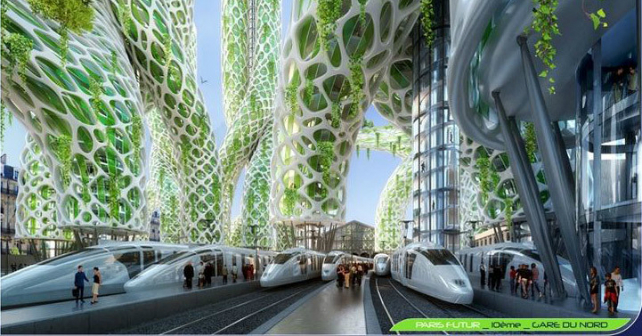
Vincent Callebaut Reimagines Paris as a Sustainable Garden
By Jen Taylor on Jul 27, 2015
When we think of Paris we imagine cafes with tables spilling out onto cobblestone streets, grand tree-lined boulevards, and the tip of the Eiffel Tower rising above a landscape of rooftops and chimneys. The city is iconic, and it’s distinct architecture is inextricably linked to its reputation as Europe’s most romantic city. This is perhaps why Vincent Callebaut’s vision of a “Smart” Paris is generating so much buzz.
The Belgian architect recently unveiled his new vision of the city, which is dominated by gently curving structures, bio-materials, and skyscrapers covered in lush greenery. His plans for a futuristic smart city work to preserve Paris’ iconic gothic, rococo, and 19th century architecture, while adding a layer of sustainable structures to the City of Light.
An eco-utopian vision of Paris
Vincent Callebaut has been described as an “eco-utopian,” developing imaginative projects that strive to address the world’s environmental and social issues through creative design. The Belgian architect’s “Paris Smart City” is a response to Paris’ Region, Climate, Air and Energy Plan, which is working to reduce gas emissions from road traffic, implement sustainable energy plans, and reduce greenhouse gas emissions. The architect designed eight prototypes of positive energy towers conceived to fight global warming in Paris. This vision for Paris not only addresses the city’s growing environmental issues, but also aims to solve Paris’ current housing and population density issues.
 Mountain Tower - via ArchDaily.com
Mountain Tower - via ArchDaily.com
Callebaut’s Smart City
In order to meet the long-term energy goals laid out in Paris’ Climate Energy Plan, Callebaut’s Smart City features buildings designed to have positive energy outputs (BEPOS). These structures are designed to produce energy for the city and encourage residents to adopt eco-friendly practices and make them a part of their daily lives.
Callebaut’s Mountain Tower, which would be situated in Paris’ historic 1st district, is a skyscraper inspired by nature and fits neatly within the existing structures of the city. This building incorporates passive heating and cooling, rainwater recycling, living green walls, and community green spaces to provide the city with clean air, reduce the urban heat-island phenomenon, and give residents a space to cultivate a sustainable lifestyle. The Bridge towers also integrate nature into the urban landscape, using amphibian inhabited bridges and funnels to harness the kinetic energy of the Seine river.
 Bridge Tower - via ArchDaily.com
Bridge Tower - via ArchDaily.com
The Bamboo Nest and Farmscape Towers are both designed to sustainably provide food for the city of Paris, reducing transportation costs and bringing rural practices to urban spaces. The Bamboo Nest is a thermodynamic tower featuring a bamboo bio-mesh, vertical, gardens, and orchards. The Farmscape Towers are also vertical urban farms located on the periphery of Paris in the 19th district.
 Farmscape Towers - via ArchDaily.com
Farmscape Towers - via ArchDaily.com
Callebaut’s designs also ensure that space and materials are used efficiently, incorporating a number of energy-producing technologies into the facade of the building. The Mangrove Tower (top image) uses honeycomb-like skins to harvest sunlight and fuel the entire building. Similarly, the Photosynthesis Towers use algae-covered bio-facades to create biofuel and generate electricity for the city. Callebaut also incorporates “Phylolights” - large wind turbines that generate energy - into several towers to help generate energy for this sustainable Smart City plan.
Many of Callebaut’s towers are mixed-use spaces with business, residential, and commercial space in a single vertical tower. This design aims to help reshape transportation patterns and reduce the city’s fuel emissions, while also encouraging residents to change their own habits and adopt rural practices as part of their daily routine.
 Bamboo Nest - via ArchDaily.com
Bamboo Nest - via ArchDaily.com
Working with nature, not against it
The Lilypad is a “half aquatic half terrestrial city” that could float in the ocean, just like its namesake. Callebaut is also responsible for the Physalia, an amphibious garden designed to clean water as it “swims” through European waterways. Callebaut is not restricted to European markets - he is also the architect behind the Dragonfly, a vertical urban farm that would stand on New York City’s East River and provide agriculture, meat, milk, poultry, and eggs to the city, reducing Manhattan’s reliance on frozen food imports.
 Photosynthesis Towers - via ArchDaily.com
Photosynthesis Towers - via ArchDaily.com
The designs build on a theme seen in the eVolo Skyscraper Competition and the larger architectural community - an attempt to emulate nature. The 2015 eVolo Skyscraper Competition featured a number of submissions that integrated with the natural environment, creating a sustainable structure that complements its surroundings, rather than conquers it.
Callebaut’s structures both emulate nature and create an ecosystem of their own. Though his towers are scattered throughout Paris, they all work together to create a more sustainable Smart City. As ArchDaily notes, “although the techniques employed are unique to each building, the overall goals of the Smart City are cohesive: respect the rich history of Paris while embracing its potential to cultivate a healthier future by decreasing environmental impacts.”
What do you think of the designs? Will Toronto's new condos ever look like these?


